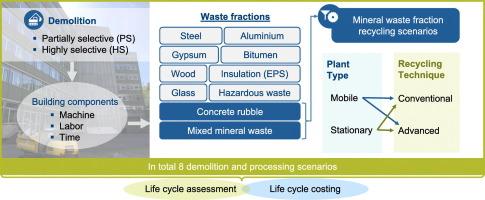Environmental and economic implications of selective demolition and advanced recycling of construction waste
IF 9.6
1区 环境科学与生态学
Q1 ENVIRONMENTAL STUDIES
引用次数: 0
Abstract
Selective demolition and high-quality recycling of construction and demolition waste are crucial for the implementation of a circular economy in the built environment. To investigate this further, we conducted a case study on a building to assess the environmental and economic potential of selective demolition and advanced recycling. Two demolition strategies (highly and partially selective) were assessed, in combination with four mineral waste recycling scenarios that differ in plant type (mobile or stationary) and recycling technique (conventional or advanced). Highly selective demolition resulted in lower environmental impacts across most categories. The global warming potential results range between −33.8 and − 15.1 kg CO2-eq/m2, with the highly selective options performing substantially better, considering the avoided impacts. The environmental differences between mineral waste recycling options were minor in most impact categories, although two exceptions occur in terrestrial ecotoxicity and ionizing radiation categories. Also, different impact methods for mineral resources lead to different outcomes, depending on whether the construction aggregates are considered within characterization factors. From an economic perspective, the difference between highly selective demolition and partially selective options is rather smaller due to higher labor costs and low market conditions for higher quality recycled aggregates. Estimates of material flows through detailed modelling of selective demolition and different options for recycling of mineral waste are essential in the context of the circular economy. The availability of primary data for detailed modelling is crucial together with the inclusion of different impact assessment methods for resource indicators and critical interpretation through sensitivity analysis.

选择性拆卸及超前回收建筑废物对环境及经济的影响
有选择性的拆除和高质量的建筑和拆除垃圾回收是在建筑环境中实施循环经济的关键。为了进一步研究这一点,我们对一座建筑物进行了案例研究,以评估选择性拆除和先进回收的环境和经济潜力。评估了两种拆除策略(高度选择性和部分选择性),并结合了四种矿物废物回收方案,这些方案在工厂类型(移动或固定)和回收技术(传统或先进)方面有所不同。高度选择性的拆除导致大多数类别的环境影响较低。全球变暖潜势的结果范围在- 33.8和- 15.1 kg CO2-eq/m2之间,考虑到避免的影响,高选择性方案的性能要好得多。在大多数影响类别中,矿物废物回收办法之间的环境差异不大,但在陆地生态毒性和电离辐射类别中有两个例外。此外,不同的矿产资源影响方法会导致不同的结果,这取决于是否在表征因素中考虑建筑骨料。从经济角度来看,由于较高的劳动力成本和较低的市场条件,高选择性拆除和部分选择性拆除之间的差异相当小。在循环经济的背景下,通过对选择性拆除和矿物废物回收的不同选择的详细建模来估计物质流动是必不可少的。提供用于详细建模的原始数据至关重要,同时纳入资源指标的不同影响评估方法以及通过敏感性分析进行关键解释。
本文章由计算机程序翻译,如有差异,请以英文原文为准。
求助全文
约1分钟内获得全文
求助全文
来源期刊

Sustainable Production and Consumption
Environmental Science-Environmental Engineering
CiteScore
17.40
自引率
7.40%
发文量
389
审稿时长
13 days
期刊介绍:
Sustainable production and consumption refers to the production and utilization of goods and services in a way that benefits society, is economically viable, and has minimal environmental impact throughout its entire lifespan. Our journal is dedicated to publishing top-notch interdisciplinary research and practical studies in this emerging field. We take a distinctive approach by examining the interplay between technology, consumption patterns, and policy to identify sustainable solutions for both production and consumption systems.
 求助内容:
求助内容: 应助结果提醒方式:
应助结果提醒方式:


